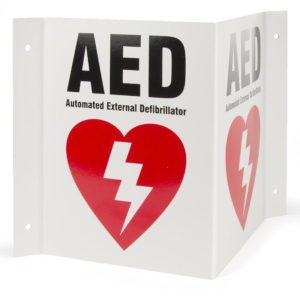Automatic external defibrillators, or AEDs, are one of the most essential tools that school communities have to keep their people safe. As a brief reminder, consider this sobering statistic. According to the National Safety Council, it takes paramedics approximately 8 to 12 minutes to respond to a scene once 911 has been called. This is of course why it is critical to call 911 as soon as possible, but it’s also why an AED can save lives. When combined with immediate delivery of CPR, early application of a defibrillator more than doubles the rate of survival for an individual in sudden cardiac arrest.

Today’s blog post is about ensuring that the AEDs on your campus are in working order. Consider incorporating some of the following items into routine safety checklists. While we hope AEDs never have to be used on campus, it is essential that they remain ready to go at a moment’s notice.
Batteries: AEDs utilize non-rechargeable batteries. They need to be replaced every 2-5 years, depending on the AED model and other factors that affect battery life. The primary AED in use at independent schools across the country is the Philips frX (if your community has a different model, go here). The Philips model has a clear indicator that informs you if the battery needs to be replaced. If the light above the power indicator is flashing green, the AED is ready for use. If the light is red, the AED is going through a self-test. Make sure to check back on it later if this is the case. If no light is visible, the battery is dead and needs to be replaced.
Pads: For the equipment to work as intended, AED pads must make proper contact with an individual’s skin. This allows for the machine to analyze the heart rhythm accurately, as well as to be able to deliver the shock. To achieve this contact, AED pads have a gel on them that bonds to the patient. Once pads are beyond their expiration date (anywhere from 18-30 months), the risk of detachment or other issues increases greatly. Your community’s AED will list the expiration date of the pads directly on the AED kit. As part of routine yearly checks, ensure that each AED has pads that are compliant.
Other Supplies and Maintenance: Other supplies that are part of an AED kit are less top of mind than pads/batteries, but may be essential to delivering a shock. For example, kits should have razors that can clear a space on the chest for pads to be placed, if necessary. Other potentially useful supplies are things like scissors (to cut away any clothing that may have wiring), CPR masks, latex gloves, and gauze. For California schools, state law requires that schools post a Cardiac Response Plan (providing a list of action items in the case of sudden cardiac arrest) next to the AED.
This document has a checklist with some of those supplies on it. It also has some useful reminders of things schools can observe that help make sure an AED is ready to go at all times. To briefly summarize - it prompts schools to verify that the AED remains clearly visible and is relatively close to a phone, that there are no visible cracks or damage on the exterior, and that no warning lights/audible indicators are coming from the AED.
To make sure that all of the above things are taken care of, we recommend that multiple members of your school community set up a recurring calendar alert, reminding them to check in on the status of all AEDs. It’s likely that you won’t always need to take additional action, but erring on the side of caution ensures that this life-saving tool is ready for action whenever required.
If you have other questions, concerns, or comments about the status of your school’s AEDs, please reach out to us at “safety@joffeemergencyservices.com”. We love chatting about all things safety!

